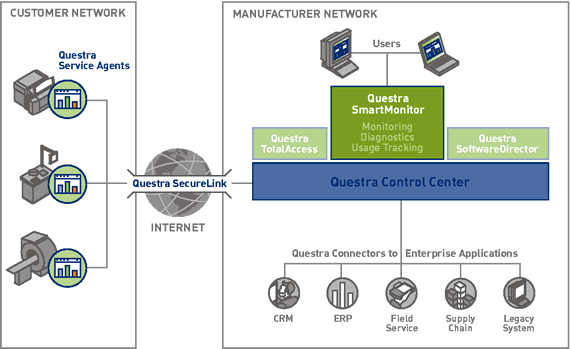
Ideally suited to geographically dispersed devices running critical business processes, the Questra SmartMonitor application allows businesses to monitor, generate alerts, and execute diagnostics on devices deployed at customer sites via a secure Internet connection. With a system of record for device performance and actionable information provided by Questra SmartMonitor, organizations can optimize service operations, proactively address customer problems, and develop new product features and service offerings that capture their customers' loyalties.

Questra SmartMonitor offers service personnel a host of customizable capabilities: monitoring, diagnostics, usage tracking, business rules to drive alerts and actions, and device performance views.
Monitoring - This capability interfaces with existing device performance data stored in log files and databases or elsewhere. When combined with business rules and scheduling, support exists for:
Configurable polling intervals for specific device performance data
Alerts based on thresholds or data values
Defined alarm conditions and alert procedures
Configurable actions for each type of alert
Diagnostics - This capability executes commands to run diagnostics remotely and return results to the server, thus leveraging existing investments in on-board diagnostics for troubleshooting and problem resolution.
Usage tracking - This capability can be customized to report on device performance data or conditions that measure equipment usage, such as hours of operation and number of tests or cycles completed. An organization can then use this data to develop new revenue models, such as usage-based rentals, usage-based warranties, or automated consumables tracking and reordering.
File transfer - Permits the transfer of images, device history information, and files for troubleshooting (thus eliminating dependence on customers to send log files or other diagnostic information to a business's support center).
Business rules - With Questra SmartMonitor, service organizations can configure business rules for easier manageability of real-time device data.
Filter data based on criteria (e.g., equipment performance thresholds, attributes, values, data source, location) before generating alerts.
Reduce network traffic and amount of data to be stored by allowing only meaningful data to get through.
Device management by group or component - This capability consolidates views of customer devices to simplify administration.
Dynamically sort devices by device type, location, customer site, or customized criteria; devices can belong to more than one group.
Perform commands or run reports against devices, a group of devices, or multiple groups of devices. Manage each group by applying optimal monitoring, usage, and fault rules for devices in the group.
Represent and manage a single device, or as a collection of components (each defined and managed separately).